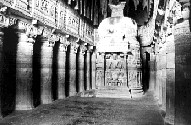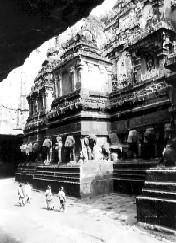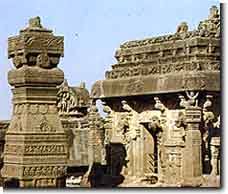KILROYTIMES
MAVERICKS HOME
SILHOUETTES 2002
ENTERTAINMENT

Buddhism was on its way out of central India by the end of the seventh century. This is obvious from the cave depiction of the divisions within the Buddhist faith, with Hinayana losing ground over Mahayana. The Buddhist caves were essentially used for prayers and were simple structures, at most with a Stupa (a semi-dome structure). Mahayana or the more dynamic vehicle replaced the Stupa with the idol of Buddha as a central figure in substantial and ornate halls where preachers (monks) lived and worshipped.
The idol was depicted as having characteristic attributes of divinity, thirty-two in all. The most apparent are the long ear-lobes, long arms, the robe, curled hair and a halo.
The simplicity of the Buddhist caves (viharas) is in contrast with the austerity of the Hindu caves (chaityas). The Kailas temple, classified as Cave number sixteen is indeed an obvious example. Sculpted out of a sheer rock face, any superlatives to define its magnificence, would merely be an understatement. This is not only a conversion of a vihara into a temple (as seen elsewhere in the cave complex at Ellora), but a fine example of what could be achieved with a chisel and hammer!
Kailasa - home of Shiva in the Himalayas has been represented in a temple form at Cave sixteen. This sculpture is regarded as the greatest monolithic sculptures in the world. The temple was sculpted in the reign of the Chalukya and Rashtrakuta Kings. The resurgence of Hinduism is evident in the grandeur of the sculpture. Kailasa depicts size and grace like no other sculpture in the world. It is said to have been built in the reign of the Rashtrakuta King, Krishna I, around 760 AD.
Life size elephants are carved in the sides of the central structure and are dwarfed by the sheer size of the 30 meter cliffs that surround the temple. Massive panels are sculpted on the walls within the temple courtyard which depict several mythological events and scriptures like for example, the epic Ramayana.
In the late 17th century however, the advancing Moguls, especially Aurangzeb AURANGABAD) defaced the temple. He called the Kailas temple and its representations 'heathen idols'. The scars are evident everywhere in the temple courtyard, yet the magnificence remains and one can easily spend a few hours looking around in awe.
In this part of the world, some of the Hindu shrines of the period were masked with typical Mogul architectural features. This to avoid the hammer of destruction, wielded by those intent on destroying religious icons or replacing or altering them with their own religious shrines. The temple and courtyard in DAULATABAD is an example of such alteration, where pillars of a pillaged Jain temple were used to build a mosque.



The numbering north developing history effected from south after and follows thereby roughly. The first twelve caves are buddhistische monasteries, only No. 10 are a temple. They developed for instance from 600 to 800 A.D.. The most interesting of them are the No. 5, 10, 11 and 12.
The caves 13 to 29 are hinduistische buildings and the most important here. Particularly the numbers 14, 15, 16 (temple dock-read), 21 and 29 are worth seeing. The dock reading temple, the perhaps largest monolithic building of the world is outstanding. It became toward end 8. Jh. from the rock gehauen and - differently than the predecessors - also from the outside opened. The worked on felsblock is long over 50 m broad, 90 m and well 35 m high. The temple has a surface area of 54 x 35 m.
The group of the jainistischen caves (30 - 34) is appropriate for about 500 m north the last hinduistischen cave. They are the youngest and developed probably from 800 to 1,000 A.D.. They do not captivate so much by their size as rather by their love for the detail. From them particularly the No. 32 is worth seeing.
The area is opened best from sunrise to sunset, the dock reading temple however only from 9.00-17.30 o'clock inspection as daily route starting from Aurangabad.
Festival: The Ellora Festival takes place usually in March at the Ellora caves, Aurangabad. This four-day dance and music festival are organized before the background of the dock reading temple. Well-known classical dancers and musician participate.

A 99 kms ride from Aurangabad takes you to the Ajanta caves. Unlike the Ellora caves, the 30 Ajanta caves are dedicated solely to Buddhism. These caves were carved out between 2nd century B.C to 6th century A.D. Ajanta caves were hidden for a long time under the thick under growth till the 19 century, when they were accidently discovered by a company of British Soldiers